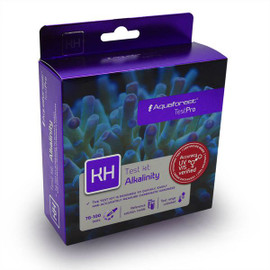Measuring range & accuracy
Measurement range: 0.1 - 20 dH
Accuracy: 0.1 dH
About alkalinity
The carbonate hardness (KH) or alkalinity* of a water sample characterises the buffering capacity, i.e. the ability to maintain the pH value of the water. It is primarily defined by the proportion of hydrogen carbonate ions in the water. As the pH value increases, other basic ions such as the hydroxide ions also contribute to the alkalinity.
The alkalinity should be tested in all aquariums regularly. If the alkalinity in the aquarium is too low, the pH value can sink (sudden drop in acidity) to a level which is life-threatening for many fish and invertebrates. In reef aquariums, an adequate alkalinity is essential for strong coral growth. On the other hand, an overly high alkalinity in saltwater tanks can lead to lime precipitates and also have a negative impact on coral growth.
Natural seawater has an alkalinity of 6.5 dH. The alkalinity in saltwater aquariums should range from 6 to 9 dH. The alkalinity in freshwater aquariums should not fall below 3 dH. The optimum alkalinity level in freshwater aquariums depends on the species of fish and plants being kept. Ask your specialist retailer for the correct alkalinity for your tank.
Instructions for use
- Shake the bottles before use!
- Rinse out the glass cuvette with tap water and then several times with aquarium water.
- Fill the glass cuvette with exactly 5 ml of aquarium water using the dosing syringe.
- Then add 3 drops of reagent A (indicator) and swirl the cuvette carefully. The water sample will turn turquoise.
- Place the enclosed dropper tip on the small syringe and draw out 1 ml reagent B (titrator).
- Now add reagent B from the syringe to the water sample drop by drop until the water changes colour from turquoise to dark-blue and violet and finally to a clear pink colour. Swirl the cuvette after each new drop. The measurement is complete when the sample has reached a clear pink colour without any blue tinge (see colour fields on the packaging).
- The consumption of reagent B (difference of 1 ml) multiplied by 10 constitutes the alkalinity in dH. Example: If the lower side of the syringe plunger is at 0.28 ml following titration, then the consumption of reagent B is 0.72 ml (difference of 1 ml). 0.72 x 10 = 7.2. The alkalinity of the aquarium water is 7.2 dH. It is possible to carry out the test with a 2.5 ml sample so that the test reagents last longer or for hard water over 10 dH. If you choose to do this, follow the procedure described above and multiply the consumption of reagent B by 20 following titration.
- Rinse out the glass cuvette, the syringe and the dropper tip thoroughly with tap water after the measurement process.
Shelf life and storage:
6 months after opening. Store in a cool, dark place.
Schedule of water hardness








